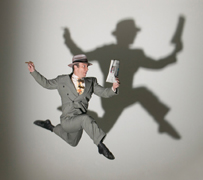
Jack Anderson
Sewell's Bright Balletic Ideas
 |
| James Sewell Ballet -- Benjamin Johnson in "Guy Noir: The Ballet." Photo by Erik Saulitis. |
James Sewell Ballet
April 4-9
Tuesday, Wednesday and Friday at 8 p.m., Thursday at 7:30 p.m., Saturday
at 2 and 8 p.m., Sunday at 2 and 7:30 p.m., $40
Joyce Theater, 175 Eighth Avenue at 19th Street, Chelsea
Tickets: (212) 242-0800 or www.joyce.org
Reviewed by Jack Anderson April 7, 2006
James Sewell creates ballets with ideas. Some of them work better than others. Nevertheless, when his Minneapolis-based James Sewell Ballet came to the Joyce Theater, it avoided familiar balletic formulas.
The featured attraction was "Guy Noir: The Ballet," a comedy-thriller inspired by Garrison Keillor's radio detective. The plot was not especially thrilling. But the comedy aroused chuckles, thanks to Sewell's gift for choreographic caricature and a taped script which Keillor recited in a deadpan fashion. Portraying the title character, Benjamin Johnson made his loose-limbed dancing a kinetic counterpart to Keillor, whose narrative took Guy to a tulle company sponsoring a contest for the best commercial involving a power tool. Keillor's text abounded with such wordplay.
The contestants included a sultry and ultimately duplicitous blonde (Peggy Seipp-Roy), a mad Russian (Justin Leaf), a fanatic modern dancer (Penelope Freeh) and two manic polka dancers (Nicolas Lincoln and Brittany Fridenstine). They were all entertainingly goofy and the sight of dancers dashing about with chainsaws and drills helped make "Guy Noir" a genuinely novel novelty.
Two plotless ballets were structurally interesting. "Anagram," to Schubert's "Sonata for Arpeggione and Piano in A minor," abounded with curving movements and soft falls to the floor. Yet, despite the smoothness of individual episodes, the dance looked slightly disjointed as a whole, perhaps because of its choreographic form.
A program note explained that "Anagram" is built from choreographic modules that can be rearranged in different orders and danced to several different scores. At this performance, choreography and music usually seemed harmonious, as when brisk leaps paralleled a musical acceleration. At another point, however, Sally Rousse was tossed into the air, only to land in the arms of two men. These actions took place to gentle music and seemed to have a puffball lightness, whereas they conceivably could have conveyed a sense of exertion to more vigorous accompaniment.
Only seeing varied arrangements of this choreography to assorted scores could reveal how effective Sewell's concept truly is. Yet it was fascinating to find a classical choreographer venturing into indeterminacy, which is usually associated with modern and postmodern dancers.
"Involution" was a steady progression. Thomas Newman's score was tumultuous at the start, as was Sewell's choreography with its jagged steps and seemingly uncontrollable tics. But as the music grew sweeter, the choreography calmed and the cast occasionally appeared to be performing ancient choric circle dances and trancelike swaying rituals.
Just as villains in fiction and drama often prove more interesting
than noble heroes, so, too, Sewell's demonically possessed individuals
were more striking than his angelic celebrants. Yet he made their journey
to serenity convincing.
| museums | NYTW mail | recordings | coupons | publications | classified |
